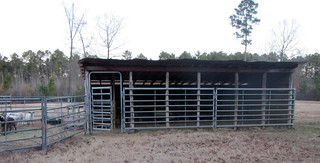Winter shelter for sheep and goats
September 26, 2014
(490 words)
PINE BLUFF, Ark. – With the arrival of fall, sheep and goat producers should begin preparing shelters for their animals so they will be ready for cold weather or winter storms.
“Sheep and goats are hardy animals and do not require as much shelter as many new producers believe,” said David Fernandez, Cooperative Extension Program livestock specialist at the University of Arkansas at Pine Bluff. As long as they are kept dry and out of the wind, sheep and goats are comfortable even when it is quite cold outside, he adds.
Build shelters so that one wall faces the direction of the prevailing wind. Three-sided shelters should face south so that winter sunlight can provide additional warmth while stormy and cold northern and northeasterly winds will be deflected.
Also, build a shelter on slightly elevated ground with good drainage. Shelters with puddles of water or muddy floors will chill livestock seeking shelter. They also create manure management problems and potential fly and parasite problems in warmer months, he says.
However, before selecting a site for a shelter, decide whether or not electricity and water will be installed. Shelters in distant pastures are typically too expensive to power, but they may have water.
“New producers often think they have to completely enclose and insulate a barn to protect their livestock,” Fernandez said. “But livestock do better with good ventilation and open air. Ammonia from urine and fecal odors can build up rapidly in enclosed structures.”
Next, consider bedding. Livestock can be bedded on many materials. Straw is traditional, but wood chips are commonly used. Dr. Fernandez warns against using sawdust for wooled breeds of sheep because it gets stuck in their fleece. Even shredded newspaper can be used. It is very absorbent, but it can be difficult to handle if it becomes too wet. When considering newspapers, think whether the bedding will be composted or spread on pastures. Newspapers compost well, but they are unsightly when spread.
Sheep and goats must have enough space in the shelter so they can use it. A mature ewe or ram requires 8 square feet of space; lambs and kids need about 6 square feet. They will not distribute themselves evenly across the floor, but they will cluster together to share body heat.
Some producers worry when they see their sheep or goats lying outside on a cold day and try to move them into the shelter, only to have the animals return to the pasture as soon as their back is turned.
“Do not worry,” Fernandez said. “As long as the weather is dry and not too windy, animals will probably prefer to be outside allowing the sun to warm them. If they get too cold, they will go to the shelter on their own.”
Shelters can be built from many inexpensive materials. Producers have made simple Quonset-covers on wheels, converted carports, pallets or reclaimed lumber, even tarps stretched over frames.
For more information on this or other livestock questions, contact Dr. Fernandez at fernandezd@uapb.edu or (870) 575-7214.
Pursuant to 7 CFR § 15.3, the University of Arkansas System Division of Agriculture offers all its Extension and Research programs and services (including employment) without regard to race, color, sex, national origin, religion, age, disability, marital or veteran status, genetic information, sexual preference, pregnancy or any other legally protected status, and is an equal opportunity institution.
By Carol Sanders, writer/editor
UAPB School of Agriculture, Fisheries and Human Sciences
(870) 575-7238
sandersc@uapb.edu
Related Links
